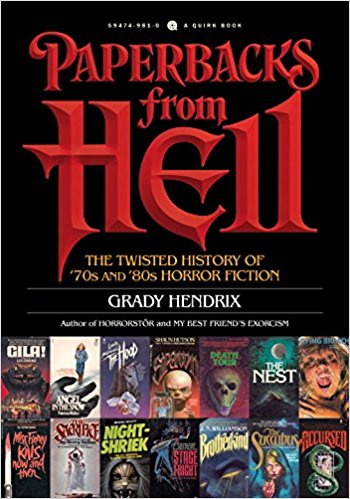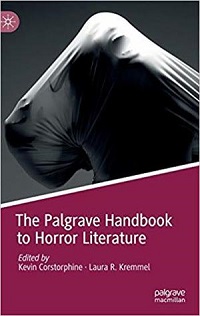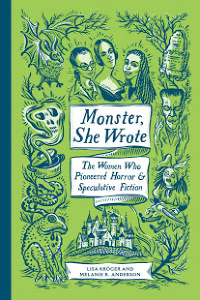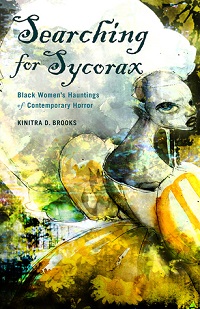Sponsored by Amazon Publishing.
Can love undo death? Writer David Thorne lost the love of his life Emily ten years ago, presumed murdered. But now he’s met a woman who looks and acts just like her. Though David knows Maddison Sutton can’t be Emily, he can’t help but be seduced by the promise of bringing his beloved back from the dead. But just who is Maddison, and what price must David pay to keep from losing her too? From international bestselling author Dean Koontz comes a twisting journey of lost love, impossible second chances, and terrifying promises. Read The Other Emily.
Hey there horror fans, I’m Jessica Avery and I’ll be delivering your weekly brief of all that’s ghastly and grim in the world of Horror. Whether you’re looking for a backlist book that will give you the willies, a terrifying new release, or the latest in horror community news, you’ll find it here in The Fright Stuff.
This week we’re going to take a little detour out of horror fiction and into the world of horror literary criticism. Why? Because I’m a nerd. Specifically I am an academic nerd who buys critical texts for fun even though she’s been out of university of four years (or four hundred years if measured in COVID-19 time). But this is more than just me indulging in my fascination with critical texts and dissecting the genre I love – though I mean what better way to show your love of the horror genre than dissection, right? … Moving on.
The real reason that I want to spotlight critical horror texts this week is because I honestly believe that all readers can benefit, and come to enjoy, reading about their genre as much as they enjoy reading in their genre! Especially since most of us, at least once in our reading lives, have encountered the sentiment that genre fiction is not worthy of critical consideration or exploration. That it has no value compared to “real” fiction. But these authors and editors have put paid to that notion, giving the horror genre and its rich, complex history the depth of critical study that deeply deserves!
The Palgrave Handbook to Horror Literature edited by by Kevin Corstorphine and Laura R. Kremmel
Palgrave’s literary criticism texts are unparalleled, really. Just so good. The Palgrave Handbook to Horror Literature, specifically, is a fantastic in-depth examination of the horror genre. Each section explores the various origins and evolutions of the genre throughout its history, highlighting themes, digging deep into classic and modern texts, and considering horror through a variety of theoretical lenses. Many chapters discuss at length issues that we see the horror community grappling with daily: gender and sexuality, race, censorship and morality, disability, and more. For a deeper understanding of the horror genre, and as a jumping off point for future inquires into horror criticism, this handbook is where you want to start! It’s a but pricy, though, so reach out to your local librarian because I bet she can find a copy for you in a university library somewhere!
Monster, She Wrote: The Women Who Pioneered Horror and Speculative Fiction by Melanie Anderson and Lisa Kröger
At this point, every knows about Monster, She Wrote, right? This book took the horror scene by storm when it was published and rightly so! Though the breadth of its a subject matter vs its length means that Anderson and Kröger’s history of women in the horror genre can sometimes feel a bit cursory in places, where this book really excels is in its role as an invitation to further study. Diving deeper than the known mothers of the genre, like Shelley and Jackson, Anderson and Kröger said “here are some incredible women you may or may not have heard of, and here are some incredible books they wrote, go forth!”. Monster, She Wrote, explores lesser known historical speculative fiction authors like Margaret Cavendish (The Blazing World) as well as modern paragons like Helen Oyeyemi (White is for Witching).
Searching for Sycorax: Black Women’s Hauntings of Contemporary Horror by Kinitra D. Brooks
Brooks’ Searching for Sycorax provides an in-depth study of Black women creators and characters within in the horror genre. Examining the works of women across the African diaspora, Brooks presents a racially gendered critical analysis of the genre that is unparalleled among modern horror criticism. Looking at both “canonical” horror texts and those by modern authors like Nalo Hopkinson (Skin Folk), NK Jemisin (The Hundred Thousand Kingdoms), and Chesya Burke (Let’s Play White), Brook examines how these authors’ works interrogate and subvert the prejudices and anxieties of the modern horror genre.

Paperbacks from Hell by Grady Hendrix
Or maybe your interest in the genre lies more in its fascinating paperback history during the horror boom of the ’70s and ’80s. Mass market paperback horrors were an astounding phenomenon that, for being relatively short lived, nevertheless laid the groundwork for the modern genre, shaping horror as we know it today. Grady Hendrix’s Paperbacks from Hell is a beloved genre history (and an absolute stunner of a book, thanks to Quirk Books) that has not only draw attention to the lost titles of horror’s early heyday but has also lead to the rediscovery and republication of many of these incredible early authors and their works.
Obviously this is just a small sample of the critical texts on offer about the horror genre. And largely based around my own interests, I admit. But one of the most beautiful things about a critical texts is the reference list in the back. One book leads to 10 or 20 others and the next thing you know you’re down rabbit hole! Go forth an enjoy!
Fresh from the Skeleton’s Mouth
Last thursday (March 25) was publication day for Stitched Lips: An Anthology of Horror from Silenced Voices, featuring works from Gabino Iglesias, Hailey Piper, Lee Murray, Lucy Snyder, and others! All profits from sales of the anthology will be donated to the Southern Poverty Law Center, whose goal is the advancement of human rights for all people.
You know those gorgeous, rainbow spine trade paperback editions of Stephen King’s novels? The ones that pop up in painfully beautiful stacks all over your Instagram feed, but you can never claim them for your own because they’re out of print from their UK publisher? Well do I have some good news for you: Hodder & Stoughton are bringing them back!
Yesssssssssssssss. Listen. I love What We Do in the Shadows more than life. They can make as many spin offs of the original as they want. It’s fine. Take my money and sign me up.
As always, you can catch me on twitter at @JtheBookworm, where I try to keep up on all that’s new and frightening.



